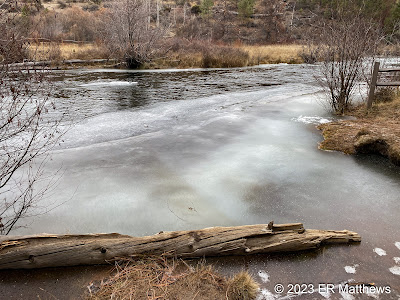I take inspiration from the land and nature in all seasons. And while spring, summer, and fall all have their merits and qualifications for being the best season to be outdoors, I do find that some of my best memories come in the bleakest of seasons, the winter, the season in which the land has an entirely different feel from the other three.
 |
| Ann Makes Her First Visit to Shevlin Park |
This week, Ann surprised me in asking me to take her to
Shevlin Park for a walk on a day that she was not going to her exercise class. Shevlin is a special place that I have wanted to share with her, special in the sense that I cannot imagine a more wonderful city park. We in Bend are so fortunate to have such a treasure at our fingertips, hard on the city limits on the northwest side of town.
In this early winter season (early winter in spirit, if not technically so according to the calendar) before everything is blanketed in snow, I can view natural ice sculptures in the rivers, the colorful stems of shrubs that are otherwise obscured by leaves, the aesthetic beauty of the remaining seed heads and berries, and take in the views of the rocks and hills that only become visible at this time of year.
I spend much time every week in the canyon of the Deschutes River on the south side of town to the point where I am quite used to that stretch of river. The walk at Shevlin along the banks of Tumalo Creek, a tributary of the Deschutes, seems quite different to me, not only in scope, but in flora, and mainly in spirit. Ann captured some of the essence quite well when she said, "It feels like we are a long way from home here."
This is a quick series of snaps taken on my phone, snaps of Shevlin Park in early winter. In this season, the leaves are off the trees, the cold weather has the creek icing up, and the crowds are absent.
Shevlin Park is home to a great collection of conifers (as well as a couple of stands of aspens) including a lot of massive Ponderosa Pines of the form that I like to call cinnamon sticks. As these trees age, they start to shed small pieces of their outer bark to expose a light reddish-brown layer of a warm color akin to cinnamon. This color, coupled with the fact that the first branches might not be until 50 feet off the ground, leads me to call them cinnamon sticks for they resemble nothing so much as that.
 |
| Shevlin is Home to Some Massive Ponderosas, Pinus ponderosa |
Shevlin is also home to the largest collection of Western Larches in the area. These somewhat scarce trees are limited primarily to the Columbia River basin and are notable for their fall color. While the vast majority of conifers are evergreen, larches along with some cypress and redwoods are notable for dropping their needles each fall and regrowing new ones in the spring. After the larches have gone golden in October, their needles fall to the ground as though some giant has sprinkled the earth with gold.
 |
| Western Larches, Larix occidentalis, Drop Their Needles in the Fall |
 |
| Walking on Larch Needles |
 |
| Still Life: Streambed Rocks and Larch Needles |
 |
Seasonal Color on Creeping Oregon Grapes, Mahonia repens
|
 |
| Glowing Patch of Red Osier Dogwood, Cornus sericea |
 |
| Tumalo Creek Framed by Red Osier Dogwoods and Ice |
 |
Winter Still Life: Snowberries, Symphoricarpos sp., and
Western Spirea Blooms, Spiraea douglassi |
 |
| Pearly Everlasting, Anaphalis margaritacea, Lasting into Winter |
 |
| Colorful Stems of Greenleaf Manzanita, Arctostaphylos patula |
 |
| A "Cinnamon Stick" |
 |
| Only in Winter Can You Truly Appreciate Massive Basalt Boulders |
























No comments:
Post a Comment